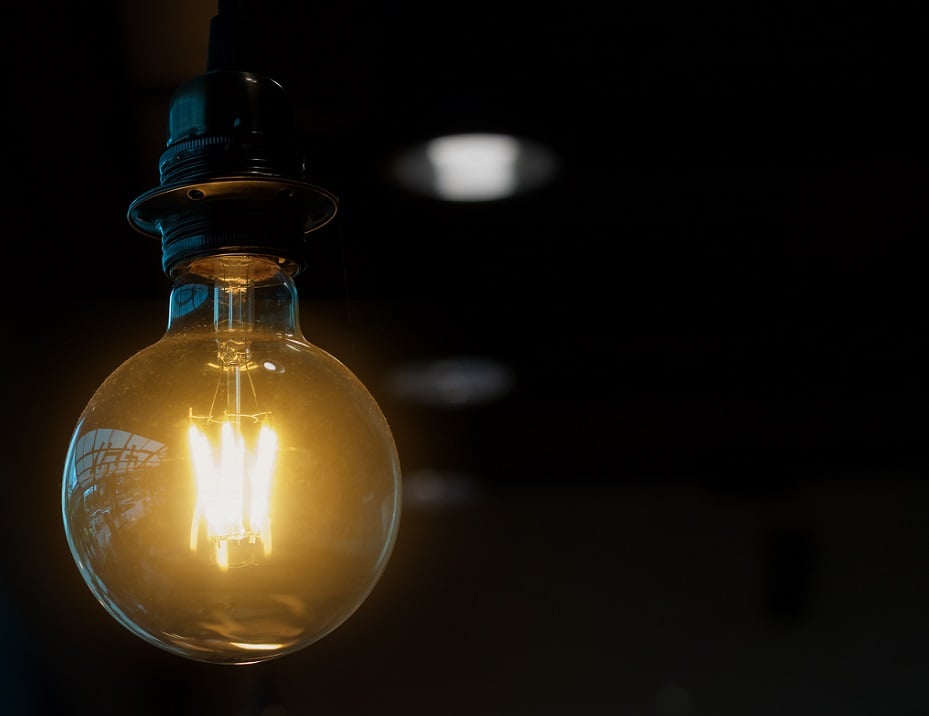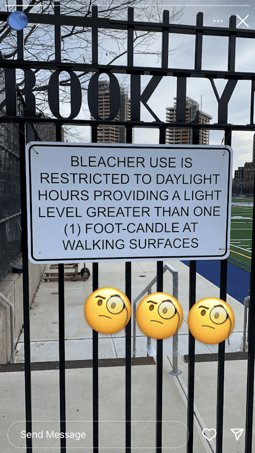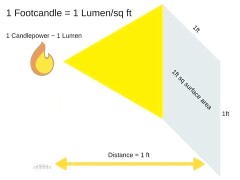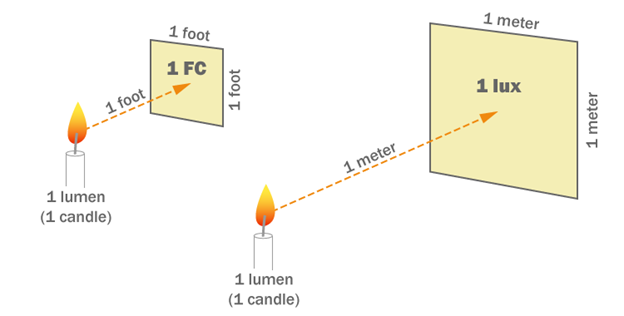Foot-Candles and Other Lighting Terms You Never Knew Existed

Every industry has its own unique lingo, and the lighting industry is no exception. While lighting technology has advanced extensively in the last several decades, giving us brighter, longer-lasting, and more efficient lighting options than ever before, some terms sound like they’re from the 1800s—and a few of them actually are!
 The photo to the right was shared on social media by a friend of mine. The sign hangs on a fence around an athletic field in Brooklyn, NY and reads, “Bleacher use is restricted to daylight hours providing a light level greater than one (1) foot-candle at walking surfaces.” When I came across my friend’s post this sign prompted some questions:
The photo to the right was shared on social media by a friend of mine. The sign hangs on a fence around an athletic field in Brooklyn, NY and reads, “Bleacher use is restricted to daylight hours providing a light level greater than one (1) foot-candle at walking surfaces.” When I came across my friend’s post this sign prompted some questions:
- What exactly is a foot-candle?
- And, how am I supposed to know if the light level is more than one of them?
- How have I worked in the optics and photonics industry this long and never heard this term!?
Before sharing the answers to these questions, defining a few other common, and equally perplexing, terms used in the world of lighting will be helpful:
- Watt: A measure of how much power is consumed by a light source. Let’s take a quick quiz. Which light is brighter—a 60 W bulb or a 100 W bulb? While many people may be tempted to think that the 100 W bulb is brighter, this question can’t be answered based on the information provided. Watts doesn’t indicate how bright a light will be; instead, it’s a measurement of how much energy is used by a light source! We can see this concept in action when we compare the brightness of a 15 W incandescent bulb to a 15 W LED bulb—the 15 W LED bulb will be much brighter even though it uses the same power as the 15 W incandescent option.
- Lumen: A measure of the total amount of visible light emitted from a light source. Light source efficiency is determined by the quantity of light emitted for each watt of power used, or lumens per watt.
Foot-Candles
So, what exactly is a foot-candle? The term foot-candle came into being before electricity was even invented and can be traced back to when beeswax candles served as the main source of lighting. Although the term is old, it’s still commonly used in the lighting industry to calculate how much light is needed in workplaces, stores, and outdoor spaces (like athletic fields in Brooklyn).
Foot-candles measure light level, or luminance. More specifically, foot-candles tell us the quantity of visible light that falls on a particular surface. While the actual amount of visible light given off by a light source is measured in lumens, the number of lumens produced can vary drastically from the number of lumens delivered—for example, when a bright light is covered by a dark shade—and that’s where foot-candles come in! Lumens tell us about the intensity of the light source itself, while foot-candles tell us how bright a light source is perceived in a space.

One foot-candle is equal to the quantity of light from a (somewhat) standard candle that falls on a surface with an area of one square foot that is one foot away from the candle and can be defined as one lumen per square foot.
To give you an idea of what foot-candle levels mean in everyday life—and to help you decipher the sign outside of that athletic field in Brooklyn—we can take a look at how many foot-candles of light are produced at different times of day:
Time of Day | Light Level
- Daytime, Full Sun: 1,000 foot-candles
- Daytime, Overcast: 100 foot-candles
- Twilight: 1 foot-candle
- Nighttime, Full Moon: 0.01 foot-candles
- Nighttime, Overcast: 0.00001 foot-candles
Lux
No discussion of foot-candles would be complete without mentioning lux, another term used to measure exactly the same thing as the foot-candle. The difference between lux and foot-candle is simply one of units—lux is based on the metric system (meters, grams, etc.), while foot-candle uses the Imperial system (feet, pounds, etc.). Similar to a foot-candle, as shown in the illustration below, one lux is the quantity of light that falls on a surface with an area of one square foot that is one meter away from a candle, and if you need to convert between the two measurements, 1 foot-candle = 10.764 lux.

To get a further sense of what a foot-candle looks like in daily life and the conversion of foot-candle to lux, let's look at the recommended foot-candle and lux ranges for a variety of visual tasks:
Visual Task
- High contrast or large-size objects:
- Recommended Foot-Candle Range: 20-50
- Recommended Lux Range: 200-500
- Medium contrast or small size objects:
- Recommended Foot-Candle Range: 50-100
- Recommended Lux Range: 500-1,000
- Low contrast or very small size objects:
- Recommended Foot-Candle Range: 100-200
- Recommended Lux Range: 1,000-2,000
- Low contrast and very small size objects over an extended timeframe:
- Recommended Foot-Candle Range: 200-500
- Recommended Lux Range: 2,000-5,000
- Very exacting visual tasks over an extended timeframe:
- Recommended Foot-Candle Range: 500-1,000
- Recommended Lux Range: 5,000-10,000
- Extremely low contrast and small size visual tasks:
- Recommended Foot-Candle Range: 1,000-2,000
- Recommended Lux Range: 10,000-20,000
Foot-candle may be a term that sounds like it hails from the dark ages, but understanding what it means can be helpful whether you’re trying to decide which light fixture is best for your needs or if there’s enough light to use the bleachers at an athletic field!
At Energetiq, we specialize in the development of ultra-bright light sources for semiconductor manufacturing, life sciences, sensor testing, food safety, and more. Contact us today to find out how we can help you solve your demanding performance challenges.


